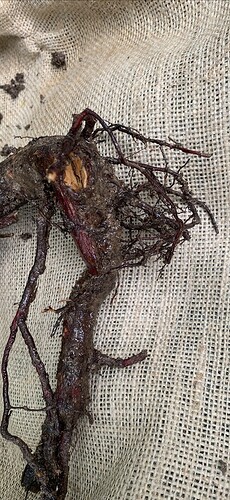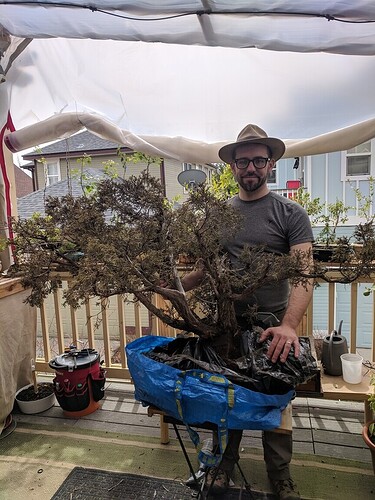I collected my first yamadori — a common juniper in the Colorado foothills. The soil it was in mostly fell away. I’ve heard and read that these aren’t supposed to be bare-rooted, and I didn’t wash away the small remaining attached soil. I did bring back some additional surrounding soil. When I plant this in a training box with pumice, should I include some of the loose soil I collected near the roots or just put in the tree mostly bare-root without additional soil? Thank you for any advice!
watch the Randy Knight stream and heal in 100% saw dust bed (essentially my understanding is this is fresh wood chips from a sawmill.) There’s a small chance it might make it given the situation IMO, but just maybe! Keep out of direct sunlight until new growth emerges and extends. There’s debates on fertilizing or not, I’m still confused.
Is this a photo of the entire root mass/structure? If not, could you include one with a ruler or common item for relative size?
I would argue against using the field soil, but am unsure what the best soil or particle size would be to encourage healthy roots in this situation.
Other more experienced members surely could help, but here’s a quick quote!
///
-M-
Also, do you think the major roots without many feeders could be trimmed back to where I put the red line on the second photo?
Thanks — I did watch that after care video from the library, it was very helpful… I guess I didn’t know if this was a “problem” root system that would need the sawdust treatment or if I should pot it in the pumice and get it in full sun quickly…
I do have one spot in my yard that would get about 1-2 hours of full sun in morning, and I could plant in sawdust, but is dappled to full shade by 10:30am. Not sure if that will be enough sun for this one, although I did collect it in a shadier spot, so it may work well.
That is the entire root mass, I would say it is about 12” long in total length.
I decided on using about a half inch of the sawdust at the bottom of the planting and then the rest pumice with no extra collected soil. Mostly as Randy suggested in the yamadori after care video… if anyone thinks that was definitely the wrong approach, please let me know! This one has some cool deadwood features, so I’d love to save it if possible.
The sawdust at the bottom of your box might pose a problem in the future.
I think there is some confusion, go back and watch the Randy Knight stream again.
The bottom layer of sawdust that Randy Knight refers to is used when healing the tree into a bed of sawdust, with a minimal layer, 1-2” on the bottom and sawdust piled up 4” over the root mass.
An ideal bottom aeration layer is a larger grain, 1/2” size of pumice.
Your soil column should consist of the same substrates, meaning that your aeration layer will be the same as your fill. If it is a 1-1-1 mix it should be that ratio all the way through or if it is just pumice then pumice all the way through.
My thought is that the sawdust that is used as a bottom layer will eventually rot and inhibit the balance of water and oxygen. It will also hold too much water and with collected material, especially junipers, great care has to be taken with the amount of water the tree is getting.
Good luck 


Shoot, that is good to know. Randy mentions at one point that he sometimes uses a very thin layer of sawdust at the bottom of his Anderson flats to prevent the pumice from falling out, but I also like your idea of using a larger grain pumice as the bottom layer… do you think it is worth re-doing it even if it disrupts the roots again? I do notice the top is drying out a lot faster than the bottom. Thanks.
The bottoms of Anderson flats have mesh pattern that allows a lot more transfer of water and oxygen, so I see why Randy would feel good about throw in a layer of sawdust chips to keep the pumice from falling out.
I’m guessing that your box doesn’t have that much water, oxygen transfer compared to a flat. That’s why I would be worried about the rotting sawdust.
You won’t have to repot it if you can get the box at an adequate height to drill a lot more holes, at least 1/2” diameter. Set a depth gauge, so you don’t hit the roots, and drill away. 
Thanks so much — I’m gonna try drilling more holes and larger in size to avoid the re-plant… you think that might be sufficient even with the box sitting directly on the ground?
Add some feet, a half inch off the ground will be enough 


Such a catch 22. Randy says trees recover better directly on the ground. While I agree eventual air exchange will be necessary, you may wish to add feet once the tree starts pushing new growth and you’re certain it’s roots/recovered from the dig.
Thanks for the feedback — it is all very helpful to consider. One other question about watering the pumice. Randy says he waters when the pumice is dry about an inch down. Do you think that means when the pumice looks dry (like same color an inch deep as on top) or when it feels dry to touch? It feels dry very fast, but sometimes still has a different shade like it’s retaining water, and living in Colorado which is much dryer than Randy’s part of the world, I want to make sure I’m watering enough but not too much. Thanks!
one option is to place it in good draining “soil” directly on the ground. That way you can evacuate the water better from the box.
Hey Matt, nice looking juniper! It is a little scarce on rootage though, I’d suggest regular misting to help it retain moisture. Junipers can actually take in water through their foliage, so that can keep them hydrated while the roots regrow. I collected a big Rocky Mountain Juniper this spring and Ryan suggested misting with half strength chemical fertilizer occasionally to give it nutrients as well. Again this is juniper specific because of their ability to take in the nutrients/water through the foliage.
Also in Denver (I’m here too) the sun is really intense, we have a mile less atmosphere to soften it so the UV is much higher than sea-level. I’d keep the tree in the shade for a few weeks then slowly give it more direct light, starting with morning light and shade in the afternoon and only give it full sun when you see it start to grow. If you’d like to meet up sometime and compare Yamadori I’d love to meet another enthusiast in the area.
Cheers,
Tim
Hi Tim, thanks so much for the local advice. I’ve been misting it some, and I’m glad to hear that’s appropriate for juniper. How often do you water your pumice in Denver? Mine seems to dry out pretty quickly, so I’ve been averaging about 2x a day. Wondering if that’s roughly what you see as well, as that’s one area I’m unsure of. I currently have it in a spot that gets sun for a couple hours in the morning, then some dappled shade. When it’s cloudy in the afternoon I’ve been moving it out from under the shade and it sometimes gets some later afternoon sun.
Would definitely be interested in meeting up for more collecting when the season is right, I could use some tips on getting more of the root ball. Post a pic of that RMJ you collected, I’m interested in taking a look!





